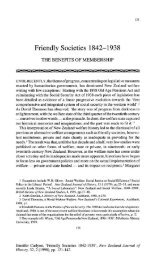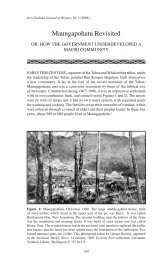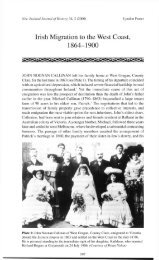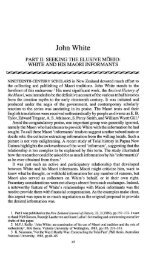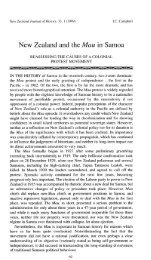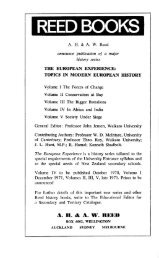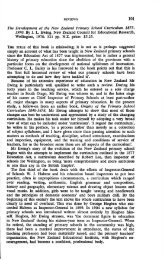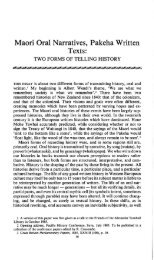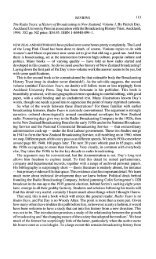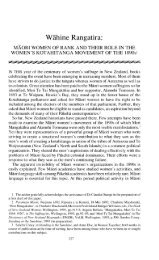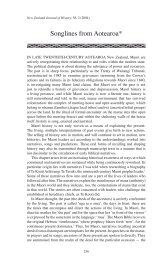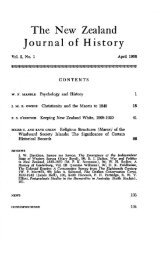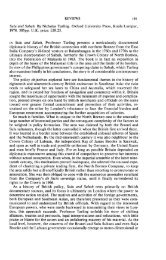Bishop G. A. Selwyn and the Melanesian Mission - New Zealand ...
Bishop G. A. Selwyn and the Melanesian Mission - New Zealand ...
Bishop G. A. Selwyn and the Melanesian Mission - New Zealand ...
You also want an ePaper? Increase the reach of your titles
YUMPU automatically turns print PDFs into web optimized ePapers that Google loves.
BISHOP G. A. SELWYN AND THE MELANESIAN MISSION 133<br />
expression of gratitude. 55 North of Efate <strong>Selwyn</strong> had a free h<strong>and</strong>,<br />
though it was to prove an empty privilege. The extent of his mission's<br />
failure to secure a base in this region during its first decade is well<br />
illustrated by its position in <strong>the</strong> Solomon Isl<strong>and</strong>s which provided fifty<br />
scholars before 1861, mainly from two places on Guadalcanal <strong>and</strong><br />
San Cristobal. Seven of <strong>the</strong>se were taken to Auckl<strong>and</strong> for two or three<br />
seasons, a few were baptized. Yet despite this large total exposure<br />
to Christian influence, <strong>the</strong>re is no record that any of <strong>the</strong>se youths<br />
made a serious attempt to embark on <strong>the</strong> evangelization of <strong>the</strong>ir own<br />
people, though it is unlikely that <strong>the</strong> mission would have omitted to<br />
record this fact had it occurred. If anything <strong>the</strong> reverse trend is more<br />
typical. Up to forty years later <strong>the</strong>re are occasional references in<br />
mission literature to <strong>Selwyn</strong>'s early scholars from San Cristobal as<br />
still pagan <strong>and</strong> strongly opposed to <strong>the</strong> mission. 56 It can of course<br />
be assumed that <strong>the</strong>se youths often talked of what <strong>the</strong>y had seen of<br />
<strong>the</strong> white man's society, of his customs <strong>and</strong> techniques as well as his<br />
religion, <strong>and</strong> in this rôie as interpreter of European ways <strong>the</strong>y no<br />
doubt performed a valuable function within <strong>the</strong>ir own society. From<br />
<strong>the</strong> st<strong>and</strong>point of <strong>the</strong> mission, however, <strong>the</strong> advantages gained were<br />
few <strong>and</strong> nebulous: friendly relations with <strong>the</strong> inhabitants of five or<br />
six districts <strong>and</strong> a smattering of <strong>the</strong>ir respective languages.<br />
Ill<br />
<strong>Selwyn</strong> played a leading part in one of <strong>the</strong> great debates of nineteenth-century<br />
Anglicanism: <strong>the</strong> place of <strong>the</strong> bishop in relation to<br />
overseas missionary work. 57 There were two opposing points of view.<br />
Evangelicals, led by <strong>the</strong> C.M.S., saw <strong>the</strong> office of bishop in practical<br />
terms as <strong>the</strong> administrator of a settled flock. On <strong>the</strong> mission field<br />
<strong>the</strong>re would be no need for <strong>the</strong> episcopal functions of confirmation<br />
<strong>and</strong> ordination until converts had been ga<strong>the</strong>red <strong>and</strong> congregations<br />
organized. On <strong>the</strong> o<strong>the</strong>r h<strong>and</strong>, <strong>the</strong>re was growing support for an<br />
argument which originated among American Episcopalians in <strong>the</strong><br />
1830s: that overseas missions should be led from <strong>the</strong> start by a bishop<br />
as successor of <strong>the</strong> apostles to whom Christ had entrusted <strong>the</strong> missionary<br />
commission. This view, based as it was on a high concept of <strong>the</strong><br />
episcopal office, had special appeal to those influenced by <strong>the</strong> Oxford<br />
Movement <strong>and</strong> indeed was largely responsible for <strong>the</strong> foundation in<br />
1841 of <strong>the</strong> Colonial <strong>Bishop</strong>rics Fund which endowed <strong>the</strong> see of <strong>New</strong><br />
55 'Had we been missionaries connected with his own Society, he could not<br />
have been kinder to us or more attentive.' Inglis, p. 309. Also John G. Paton,<br />
<strong>Mission</strong>ary to <strong>the</strong> <strong>New</strong> Hebrides: An Autobiography, 5th ed., London, 1890, I,<br />
282-3. For an example of <strong>Selwyn</strong>'s aid to Geddie, in 1850, see G. S. Parsonson,<br />
'Early Protestant <strong>Mission</strong>s in <strong>the</strong> <strong>New</strong> Hebrides 1839-1865', pp. 28-29, TS,<br />
Hocken Library, M. 1. 639.<br />
56 e.g. The Sou<strong>the</strong>rn Cross Log, January 1898, p. 34.<br />
r > 7 Owen Chadwick, Mackenzie's Grave, London, 1959, pp. 20-23; Hans<br />
Cnattingius, <strong>Bishop</strong>s <strong>and</strong> Societies: A Study of Anglican Colonial <strong>and</strong> <strong>Mission</strong>ary<br />
Expansion 1698-1850, London, 1952, pp. 195-206; Eugene Stock, The History of<br />
<strong>the</strong> Church <strong>Mission</strong>ary Society, London, 1899, I, 408-10, II, 19-21.



